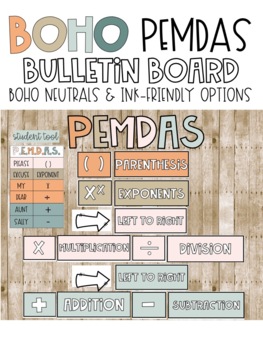PEMDAS Bulletin Board & Student Tool - Boho
Teach Me Silly
1.1k Followers
Grade Levels
3rd - 8th
Subjects
Resource Type
Standards
CCSS4.OA.A.1
CCSS4.OA.A.2
CCSS4.OA.A.3
CCSS5.OA.A.1
CCSS5.OA.A.2
Formats Included
- PDF
Pages
62 pages
Teach Me Silly
1.1k Followers
What educators are saying
My student love being able to just look at the wall when they forget order of operations! It is so helpful and goes with the theme of my classroom as well!
This is a beautiful and simple visual! I can't wait to put it up in my classroom this year. It is so big, easy to read, and is going to be so useful.
Description
Quick print the boho neutral colored PEMDAS bulletin board pieces of your choice.
*Also Included: colored and B&W Student PEMDAS Tools
Choose From:
2 PEMDAS heading fonts
2 arrow styles
Spelled out & abbreviated operations
**Black and White ink-friendly version included to quick print on colored card stock!
Also see my Math Key Words Bulletin Board, my Boho Place Value Chart Bulletin Board, and my Metric Conversions Bulletin Board.
Total Pages
62 pages
Answer Key
N/A
Teaching Duration
N/A
Report this resource to TPT
Reported resources will be reviewed by our team. Report this resource to let us know if this resource violates TPT’s content guidelines.
Standards
to see state-specific standards (only available in the US).
CCSS4.OA.A.1
Interpret a multiplication equation as a comparison, e.g., interpret 35 = 5 × 7 as a statement that 35 is 5 times as many as 7 and 7 times as many as 5. Represent verbal statements of multiplicative comparisons as multiplication equations.
CCSS4.OA.A.2
Multiply or divide to solve word problems involving multiplicative comparison, e.g., by using drawings and equations with a symbol for the unknown number to represent the problem, distinguishing multiplicative comparison from additive comparison.
CCSS4.OA.A.3
Solve multistep word problems posed with whole numbers and having whole-number answers using the four operations, including problems in which remainders must be interpreted. Represent these problems using equations with a letter standing for the unknown quantity. Assess the reasonableness of answers using mental computation and estimation strategies including rounding.
CCSS5.OA.A.1
Use parentheses, brackets, or braces in numerical expressions, and evaluate expressions with these symbols.
CCSS5.OA.A.2
Write simple expressions that record calculations with numbers, and interpret numerical expressions without evaluating them. For example, express the calculation “add 8 and 7, then multiply by 2” as 2 × (8 + 7). Recognize that 3 × (18932 + 921) is three times as large as 18932 + 921, without having to calculate the indicated sum or product.





